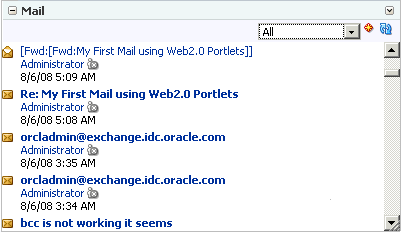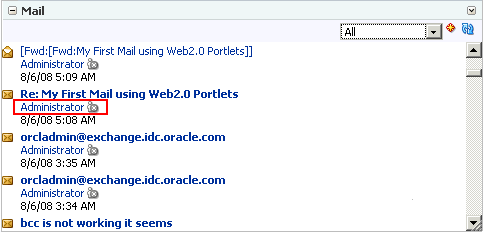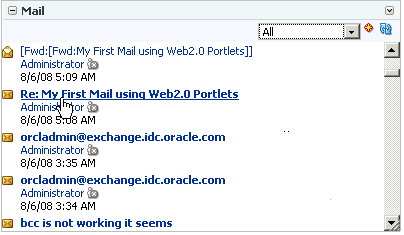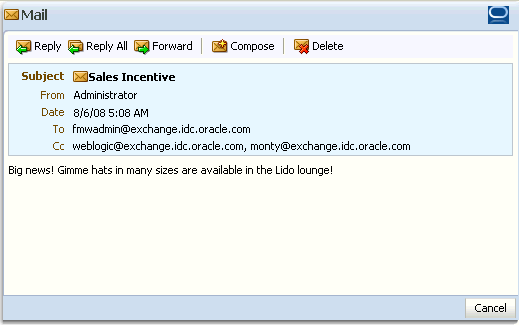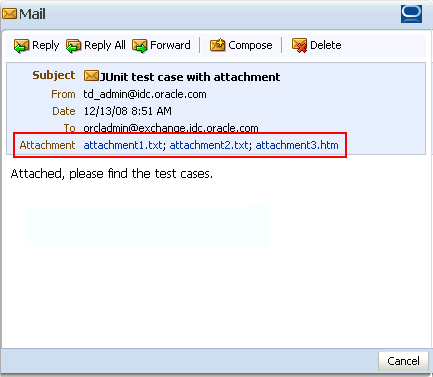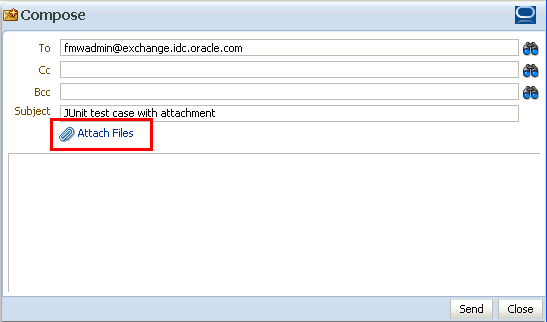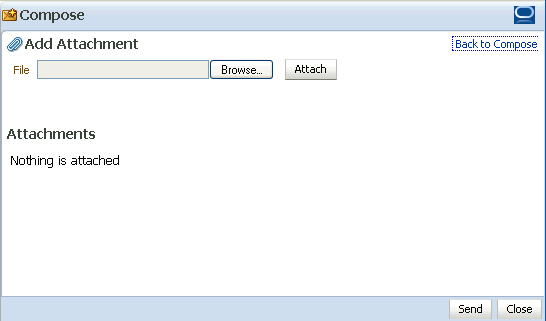25 Working with the Mail Service
The Mail service conveniently exposes familiar mail functionality in your WebCenter application interface. The Mail service runs against the same mail server that provides your regular business e-mail. The mail messages exposed in your WebCenter application are the same messages you would see in your regular mail inbox. Many of the same actions are also supported. For example, you can send messages with attachments, forward messages, and so on.
The Mail service does not replace your company e-mail, but rather enhances it by making it accessible within WebCenter.
This chapter provides information on how the Mail services exposes Microsoft Exchange features in your custom WebCenter applications and WebCenter Spaces applications. It contains the following sections:
This chapter is intended for users who want to understand and use Mail service features in the WebCenter application.
The WebCenter Spaces application administrator has the authority to expose or hide task flows from a particular service. Tasks discussed in this chapter are not available to you if the relevant service is hidden.
Note:
For information about WebCenter Spaces seeded user roles, see Oracle Fusion Middleware Administrator's Guide for Oracle WebCenter.25.1 What You Should Know About the Mail Service
The Mail service enables users to perform simple mail functions, such as view, read, create and create with attachments, reply, forward, and delete. All mail is stored in your inbox and can be accessed from there through a link.
The Mail service fetches mails from the Inbox folder only. Fetching of mails from other folders and moving of messages is not supported.
The Mail service does not replace your regular mail client; it simply enables you to use mail in a WebCenter application's collaborative environment. The Mail service supports any mail server based on IMAP4 and SMTP protocol. A WebCenter Spaces application provides access to multiple mail connections. You can use a different mail connection by selecting it in the application's Preferences settings. For more information, see Section 3.3.9, "Selecting Your Preferred Mail Connection."
Note:
You can add a Mail task flow to your page from the Catalog dialog box in Oracle Composer. For information about adding a task flow, see Section 7.1.3, "Adding Task Flows to a Page."However, all instances of the Mail task flow in an application run against the same mail server and it serves no purpose to add multiple Mail task flow instances. This is true for all service task flows that require connections to back-end servers, for example, task flows from Discussions, Announcements, and IMP services.
The Mail service exposes features from your company's mail server through the Mail task flow, which can be accessed in two ways:
-
the Mail task flow, available to both custom WebCenter applications and WebCenter Spaces (Figure 25-1).
-
The Mail panel in the WebCenter Spaces Sidebar (WebCenter Spaces applications only) (Figure 25-2).
Figure 25-2 The Mail Panel in the WebCenter Spaces Sidebar
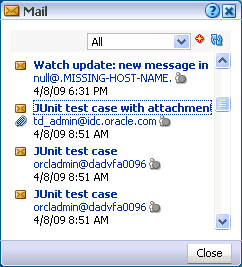
Description of "Figure 25-2 The Mail Panel in the WebCenter Spaces Sidebar"
The Mail panel is simply the Mail task flow provided in the fixed location of the WebCenter Spaces Sidebar.
The Mail task flow presents the following features:
-
A menu for specifying which messages to display
-
A Compose icon for starting the process of creating a new message
-
A Refresh icon for updating the task flow with new messages
Within WebCenter Spaces, a group space moderator can configure the Mail service to automatically create a mailing list of all group space members. Once configured, as members are added to or deleted from the group the mailing list is updated automatically. For more information, see Section 11.3.2, "Configuring a Custom Group Space Mail Distribution List." All mails sent to a group space mailing list are also posted to the group space discussion forum.
Use Mail service features to contact other WebCenter application users and any users recognized by the back-end server that supports the Mail service.
The Mail service is integrated with the Instant Messaging and Presence (IMP) service to provide additional options for contacting others. Each mail message includes the sender's user name and status icon (Figure 25-3), which you can click to open a context menu with options for starting a chat session, calling over VoIP, and the like.
Note:
If the IMP service is not configured in your application, the status icons are grayed out and do not provide context menus.For more information, see Chapter 22, "Working with the Instant Messaging and Presence Service (IMP)."
Users with page-edit privileges can access the task flow's region parameter through the Component Properties dialog box in Oracle Composer. For information about accessing the Component Properties dialog box and editing properties, see Section 7.4.2, "Setting Component Properties."
For more information about setting the Mail service task flow properties, see Section 25.3, "Setting Mail Service Task Flow Properties."
25.2 Working with the Mail Service Task Flow
The Mail task flow exposes your company's mail server features within the context of your application. Use the Mail task flow to view, respond to, and manage your personal mail.
This section provides information on how to use the Mail task flow. It contains the following subsections:
25.2.1 Logging in to Mail
Before you can access your mail in a WebCenter application, you must provide your mail login credentials. The first time you access a Mail task flow, it displays the message depicted in Figure 25-4.
Figure 25-4 Login Message in a Mail Task Flow
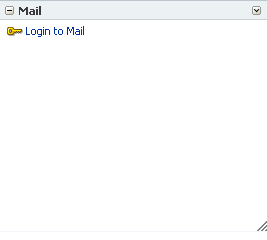
Description of "Figure 25-4 Login Message in a Mail Task Flow"
To log in to a Mail task flow:
-
Go to a Mail task flow, and click the Login to Mail link (Figure 25-4) to open an External Application Login dialog box (Figure 25-5).
Figure 25-5 External Application Login Dialog Box

Description of "Figure 25-5 External Application Login Dialog Box"
Note:
The External Application Login dialog box may include additional fields and information, depending on the requirements of the service that provides it. For more information about external applications and storing your login credentials in a WebCenter Spaces application, see Section 3.3.6, "Providing Login Information for External Applications." -
Enter your user name and password and any other login credentials that your mail application requires.
Required fields are marked with an asterisk (*).
-
Optionally, select Remember my login information to store your credentials.
The next time you log in to the application, your mail credentials are retrieved from storage and you are logged in.
-
Click OK, and the Mail task flow displays mails from your Inbox.
25.2.2 Personalizing Your View of the Mail Task Flow
You can personalize your view of a Mail task flow by selecting a cut-off point for displayed messages. For example, you can select to display only the messages that were delivered Today, Since Yesterday, This Week, or This Month. Additionally, you can select to display All messages in your inbox.
Note:
By default, the Mail service displays50 recent mail messages from your mail server Inbox folder. However, if required, your Fusion Middleware administrator can configure this to a higher value, for all users, if your server supports the increase in memory cache that fetching additional mail requires. Care should be taken to have a value suitable to your environment. This value impacts all users. That is, if the Mail service is configured to read 200 recent mail messages, then the Mail service reads 200 recent mail messages for all users.Personalizations affect only your view of the Mail task flow. No other user's view is changed because of your selection.
To personalize your view of the Mail task flow:
-
Go to the Mail task flow.
-
Open the menu at the top of the task flow (Figure 25-6).
Figure 25-6 The Mail Personalization Menu

Description of "Figure 25-6 The Mail Personalization Menu"
-
Select a display option.
Choose from:
-
All—to show all messages
-
Today—to show all messages received today
-
Since Yesterday—to show all messages received yesterday and today
-
This Week—to show all messages received in this calendar week
-
This Month—to show all messages received in this calendar month
The Mail task flow redraws, displaying only those messages that match your selection.
-
25.2.3 Opening Mail Messages
The messages that display in your Mail task flow are the same messages that display in your regular e-mail application inbox. You open them in much the same way, too. This section tells you how.
To open a mail message:
-
Go to a Mail task flow, and click the link to the message you want to open (Figure 25-7).
-
The message opens (Figure 25-8).
-
After reading the message click the Cancel button to close the message (Figure 25-9).
Figure 25-9 The Cancel Button on a Mail Message
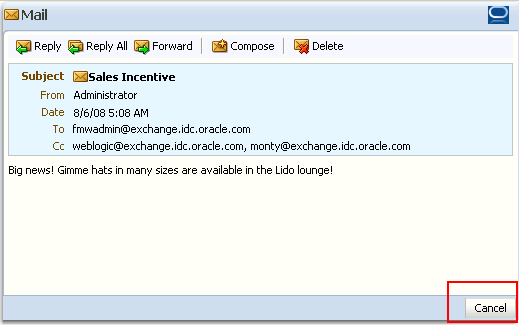
Description of "Figure 25-9 The Cancel Button on a Mail Message"
25.2.4 Downloading Mail Attachments
Attachments display in mail messages as links (Figure 25-10).
Accessing files associated with attachments is the same as accessing a file from any browser window: simply click the link. Clicking an attachment link opens a download dialog box that gives you the option of viewing the file in its native application or saving the file to a local drive. This is browser behavior, so the way you follow through depends on the browser you use.
25.2.5 Composing and Sending Mail Messages
Composing and sending messages through the Mail service in a WebCenter application is very much like doing so in your regular e-mail. This section describes how.
To compose and send a mail message:
-
In a Mail task flow, click the Compose icon (Figure 25-11).
-
Figure 25-11 The Compose Icon on a Mail Task Flow
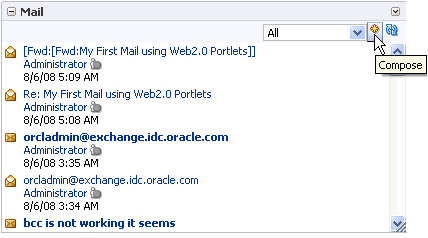
Description of "Figure 25-11 The Compose Icon on a Mail Task Flow"
-
In the resulting Compose window (Figure 25-12), enter recipients in the To, CC, and BCC fields as you require.
In a given field, separate multiple entries with a comma (,).
The Compose window is directly connected to your mail server, so you can use the Find User icons (Figure 25-13) to find mail addresses and contacts.
Figure 25-13 Find User Icons in a Compose Window
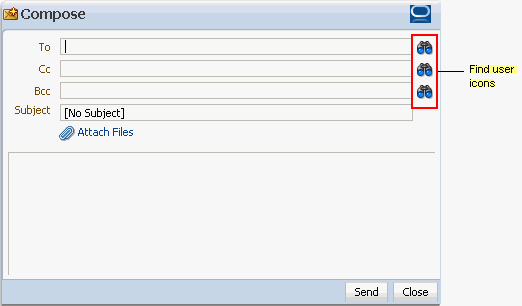
Description of "Figure 25-13 Find User Icons in a Compose Window"
Click the Find User icon and, in the resulting dialog box, enter—minimally—the first two characters of the user name for which you are searching. Click the Search button, and all names matching your search criteria appear in the results area.
-
In the Subject field, enter a subject for your message.
Enter up to 255 characters.
-
Compose your message. Mail service enables you to compose only plain text messages.
-
Click the Send button (Figure 25-14).
Figure 25-14 The Send Button in a Compose Window
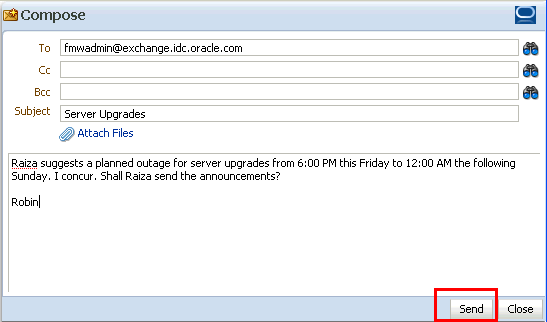
Description of "Figure 25-14 The Send Button in a Compose Window"
25.2.6 Sending Mail with Attachments
Just like your regular mail, you can use the Mail task flow to send messages with attachments. This section tells you how.
To send a mail with attachments:
-
Create a mail message as described in Section 25.2.5.
-
In the Compose window, click the Attach Files link (Figure 25-15).
The Add Attachment window opens (Figure 25-16).
-
Click the Browse button to locate and select an attachment.
-
Click the Attach button to attach the selected file.
The file size must be greater than zero bytes but lesser than 2 MB. Zero-byte files do not get attached.
Note:
It is recommended that you avoid attaching large files with your mail as this causes the server to slow down or not respond. If you attach large files (greater than 2MB), because of how the HTTP protocol handles attachments, the system reports an error only after reading all of the 2MB characters. -
Repeat steps 3 and 4 to add additional attachments.
Attachments are listed under the Attachments heading in the Add Attachment window (Figure 25-17).
Figure 25-17 Attachments in the Add Attachment Window

Description of "Figure 25-17 Attachments in the Add Attachment Window"
A Remove Attachment icon appears next to each attachment (Figure 25-17). Click this to remove a selected attachment from the window.
-
Click the Back to Compose link if you want to go back to the Compose window.
-
Click the Send button.
25.2.7 Removing Attachments from the Add Attachment Window
You can remove attachments from the Add Attachment window and from the Compose window:
-
To remove mail attachments from the Add Attachment window, click the Remove Attachment icon next to the attachment you want to remove (Figure 25-18).
Figure 25-18 Attachments in the Add Attachment Window

Description of "Figure 25-18 Attachments in the Add Attachment Window"
Note:
For information on accessing the Add Attachment window, see Section 25.2.6, "Sending Mail with Attachments." -
To remove mail attachments from the Compose window, click the Remove Attachment icon next to the attachment you want to remove (Figure 25-19).
Figure 25-19 Remove Attachment Icon in the Compose Window
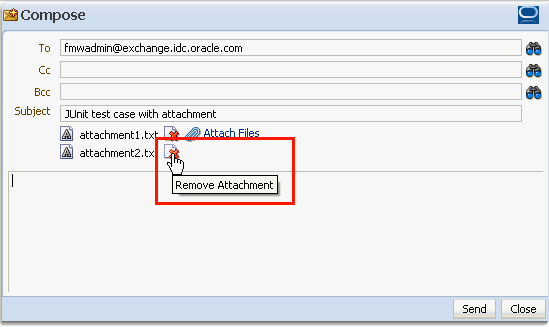
Description of "Figure 25-19 Remove Attachment Icon in the Compose Window"
Note:
For information about accessing the Compose window, see Section 25.2.5, "Composing and Sending Mail Messages."
25.2.8 Replying to and Forwarding Mail
When you reply to or forward a mail, the mail content is sent as an attached HTML file instead of being displayed in the mail message window. Replying to and forwarding mail is as straightforward as in your regular mail application. This section describes how.
To reply to or forward a mail message:
-
Go to a Mail task flow.
-
Click the link to the message you want to reply to or forward (Figure 25-20).
The message opens (Figure 25-21).
-
Select one from the following options:
-
Click the Reply button to reply to the sender. Figure 25-22 shows the resulting Mail window.
-
Click the Reply All button to reply to all recipients (including users who received a blind copy).
-
Click the Forward button to send the message on to a third party. Figure 25-23 shows the resulting window.
Figure 25-23 A Forwarded Mail Message Window
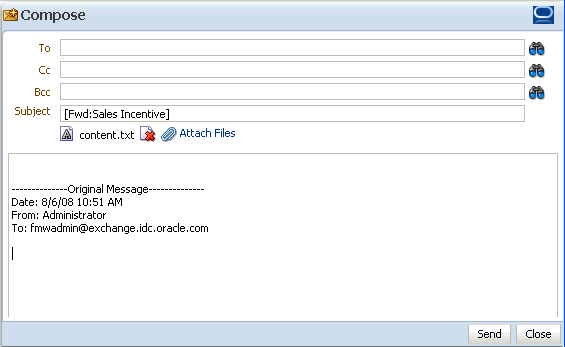
Description of "Figure 25-23 A Forwarded Mail Message Window"
-
-
In the resulting Mail window, enter recipients in the To, CC, and BCC fields as you require.
In a given field, separate multiple entries with a comma (,).
The Compose window is directly connected to your mail server, so you can use the Find User icons, next to the To, Cc, and Bcc fields, to find mail addresses and contacts.
Click the Find User icon and, in the resulting dialog box, enter—minimally—the first two characters of the user name for which you are searching. Click the Search button, and all names matching your search criteria appear in the results area.
-
Optionally, revise the subject in the Subject field.
-
In the Mail's message area, enter your reply or any forwarding message before or after the original message.
-
Optionally, add attachments as described in Section 25.2.6, "Sending Mail with Attachments."
-
Click Send.
The message is sent, and the original message reappears.
-
Click the Cancel button at the bottom of the original message to close the window (Figure 25-24).
25.2.9 Refreshing Mail
You must perform a refresh to check for new mail messages. As the refresh operation triggers an event to the server to check for new mails, it may take a while to get new messages. Therefore, you may have to refresh a couple of times to display new mails in the Mail task flow. This section tells you how to perform a refresh.
To refresh Mail:
-
Go to the Mail task flow.
-
Click the Refresh icon (Figure 25-25) on the task flow.
Figure 25-25 The Refresh Icon on the Mail Task Flow

Description of "Figure 25-25 The Refresh Icon on the Mail Task Flow"
The Mail task flow displays the latest mails.
25.2.10 Deleting Mail
You can easily clear a messages you no longer need from your inbox. This section tells you how.
To delete a Mail message:
-
Open the message you want to delete as described in Section 25.2.3, "Opening Mail Messages."
-
Click the Delete button at the top of the message.
25.3 Setting Mail Service Task Flow Properties
The Mail service task flow has associated properties, which users with sufficient privileges can access from the Component Properties dialog box in Oracle Composer. The method for accessing task flow properties is the same from task flow to task flow. For more information, see Section 7.4, "Setting Properties on Page Content."
The task flow parameters listed on the Parameters tab control the default task flow content and facilitate the wiring of the task flow to page parameters and page definition variables. Parameters are unique to the task flow type. This section describes the parameters provided by the Mail task flow.
Note:
For information about wiring components and consuming page parameters and variables, see Chapter 8, "Wiring Pages, Task Flows, Portlets, and UI Components".Changes to the display- and style-related properties listed on the other tabs affect the appearance and behavior of the Mail task flow instance for all users. These properties are common for all task flows. For more information, see Section 7.4, "Setting Properties on Page Content."
The contents of the Events tab depend on the events supported by the task flow. For more information, see Section 7.4.7, "Working with Component Contextual Events."
25.3.1 Region Parameters
The Mail task flow has one associated region parameter: Tabular. Using the EL value type, enter a value of true to display the information associated with a mail message, such as its subject, sender, and, date sent, in a tabular format. Figure 25-26 illustrates a tabular format Mail task flow.
Figure 25-26 A Mail Task Flow where the Region Parameter Tabular Is Set to True

Description of "Figure 25-26 A Mail Task Flow where the Region Parameter Tabular Is Set to True"
For detailed information about Region Parameter properties, see Section 7.4.3, "Working with Component Parameters."
